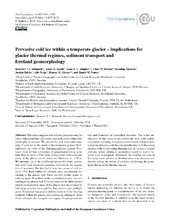| dc.contributor.author | Reinardy, Benedict T.I. | |
| dc.contributor.author | Booth, Adam D | |
| dc.contributor.author | Hughes, Anna L.C. | |
| dc.contributor.author | Boston, Clare M. | |
| dc.contributor.author | Åkesson, Henning | |
| dc.contributor.author | Bakke, Jostein | |
| dc.contributor.author | Nesje, Atle | |
| dc.contributor.author | Giesen, Rianne H. | |
| dc.contributor.author | Pearce, Danni | |
| dc.date.accessioned | 2020-06-10T14:03:18Z | |
| dc.date.available | 2020-06-10T14:03:18Z | |
| dc.date.issued | 2019-03-07 | |
| dc.Published | Reinardy BT, Booth AD, Hughes A.L.C., Boston CM, Åkesson H, Bakke JB, Nesje A, Giesen RH, Pearce. Pervasive cold ice within a temperate glacier – implications for glacier thermal regimes, sediment transport and foreland geomorphology.. The Cryosphere. 2019;13(3):827-843 | eng |
| dc.identifier.issn | 1994-0424 | en_US |
| dc.identifier.issn | 1994-0416 | en_US |
| dc.identifier.uri | https://hdl.handle.net/1956/22526 | |
| dc.description.abstract | This study suggests that cold-ice processes may be more widespread than previously assumed, even within temperate glacial systems. We present the first systematic mapping of cold ice at the snout of the temperate glacier Midtdalsbreen, an outlet of the Hardangerjøkulen icefield (Norway), from 43 line kilometres of ground-penetrating radar data. Results show a 40 m wide cold-ice zone within the majority of the glacier snout, where ice thickness is <10 m. We interpret ice to be cold-based across this zone, consistent with basal freeze-on processes involved in the deposition of moraines. We also find at least two zones of cold ice up to 15 m thick within the ablation area, occasionally extending to the glacier bed. There are two further zones of cold ice up to 30 m thick in the accumulation area, also extending to the glacier bed. Cold-ice zones in the ablation area tend to correspond to areas of the glacier that are covered by late-lying seasonal snow patches that reoccur over multiple years. Subglacial topography and the location of the freezing isotherm within the glacier and underlying subglacial strata likely influence the transport and supply of supraglacial debris and formation of controlled moraines. The wider implication of this study is the possibility that, with continued climate warming, temperate environments with primarily temperate glaciers could become polythermal in forthcoming decades with (i) persisting thinning and (ii) retreat to higher altitudes where subglacial permafrost could be and/or become more widespread. Adversely, the number and size of late-lying snow patches in ablation areas may decrease and thereby reduce the extent of cold ice, reinforcing the postulated change in the thermal regime. | en_US |
| dc.language.iso | eng | eng |
| dc.publisher | EGU | en_US |
| dc.rights | Attribution CC BY | eng |
| dc.rights.uri | http://creativecommons.org/licenses/by/4.0/ | eng |
| dc.title | Pervasive cold ice within a temperate glacier – implications for glacier thermal regimes, sediment transport and foreland geomorphology. | en_US |
| dc.type | Peer reviewed | |
| dc.type | Journal article | |
| dc.date.updated | 2020-02-17T17:13:13Z | |
| dc.description.version | publishedVersion | en_US |
| dc.rights.holder | Copyright 2019 The Author(s) | en_US |
| dc.identifier.doi | https://doi.org/10.5194/tc-13-827-2019 | |
| dc.identifier.cristin | 1689714 | |
| dc.source.journal | The Cryosphere | |

